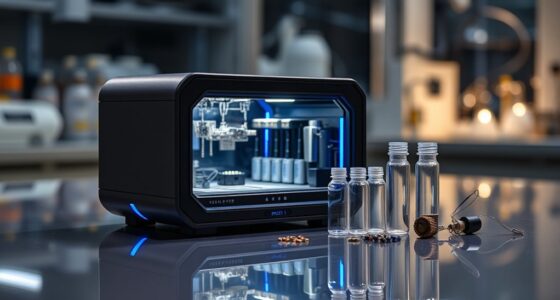If you’re looking for the best portable GPUs for machine learning in 2025, I recommend checking out options like the OneXGPU 2 eGPU with AMD RX 7800M, NVIDIA RTX PRO 6000, or the PNY GeForce RTX 5090. Compact designs and high-performance specs, including large VRAMs and advanced AI cores, make these perfect for on-the-go ML tasks. Keep exploring to discover more about these powerful portable solutions that fit your needs.
Key Takeaways
- High-performance portable GPUs like RTX 5080 and RTX 5090 offer advanced AI features and large memory for efficient machine learning tasks on the go.
- Compact, lightweight designs with robust cooling solutions ensure stability and portability for mobile ML workflows.
- Compatibility with Thunderbolt 4, USB4, and PCIe 5.0 enables seamless connection to laptops and portable workstations.
- Support for high-speed memory (up to 3200 MHz) and AI cores accelerates training and inference processes in portable setups.
- Premium models provide the power and stability needed for demanding ML workloads, making them ideal for professionals on the move.
OneXGPU 2 eGPU with AMD RX 7800M 12GB GDDR6
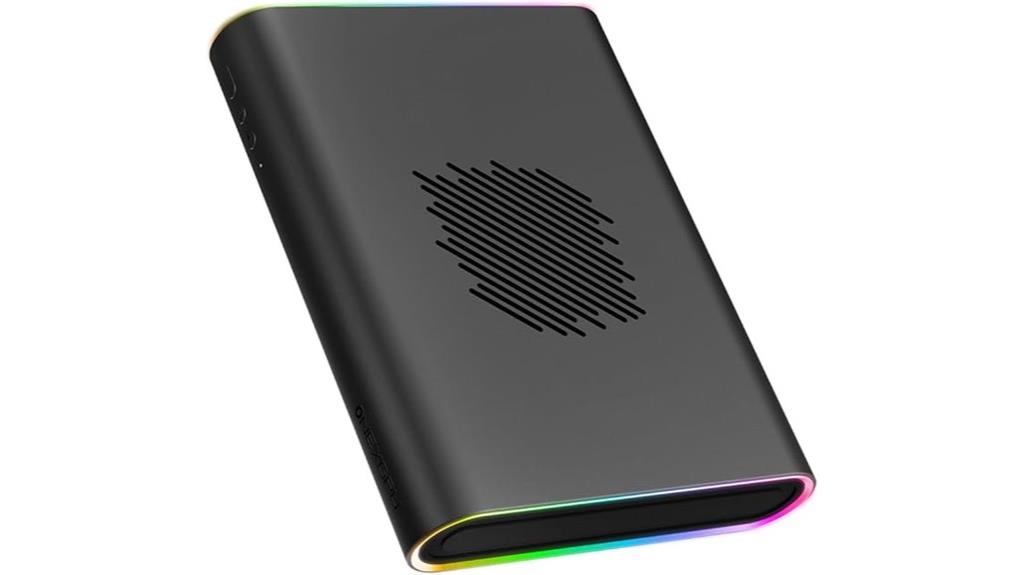
The OneXGPU 2 eGPU with AMD RX 7800M 12GB GDDR6 is an excellent choice for users who need portable GPU power for gaming, content creation, or machine learning on the go—especially if they work with Windows-based laptops or handheld PCs. It supports Thunderbolt 3/4, USB 4, and OCuLink, making it compatible with various laptops like the MSI Claw but not with MacBooks. Weighing just 3.5 pounds, it offers impressive performance, delivering up to 26% faster results than the RTX 4070 Laptop GPU. Its switchable TDP (130W/180W) boosts performance, perfect for demanding tasks like real-time processing and training models.
Best For: users with Windows-based laptops or handheld PCs seeking portable GPU performance for gaming, content creation, or machine learning on the go.
Pros:
- Delivers up to 26% faster performance than RTX 4070 Laptop GPU, enhancing gaming and productivity.
- Supports multiple video outputs (HDMI 2.1 and dual DP 2.0) for up to three displays simultaneously.
- Switchable GPU TDP (130W/180W) allows performance tuning for demanding tasks.
Cons:
- Complex setup requiring manual driver installation and frequent updates, which can be time-consuming.
- Large power brick and size limit portability, making it less suitable for on-the-move use without access to outlets.
- Limited compatibility with macOS and M-series Macs, restricting use to Windows systems.
NVD RTX PRO 6000 Graphics Card for AI and Design

For professionals demanding top-tier performance in AI, design, and simulation, the NVD RTX PRO 6000 stands out thanks to its massive 96GB DDR7 ECC memory, enabling large-scale projects without bottlenecks. Its advanced architecture includes 4th Gen RT and 5th Gen Tensor Cores, delivering up to three times the performance of previous generations. Features like DLSS 4 and neural shaders enhance AI modeling and rendering, while PCIe Gen 5 ensures rapid data transfer. The double-Flow-Through cooling maintains efficiency under 600W, and support for high-resolution displays up to 8K makes it ideal for professional workflows. Despite some initial software quirks, it’s a high-value, compact, and powerful workstation GPU.
Best For: professionals in AI, design, simulation, and engineering who require high memory capacity and cutting-edge performance for large-scale projects.
Pros:
- Massive 96GB DDR7 ECC memory supports large models and datasets without bottlenecks.
- Up to 3X performance improvement with 4th Gen RT and 5th Gen Tensor Cores, ideal for demanding workloads.
- Compact dual-slot design with efficient double-Flow-Through cooling and PCIe Gen 5 support enhances performance and compatibility.
Cons:
- May require additional software adjustments, especially on Linux, due to new Blackwell architecture.
- Initial support and driver stability issues reported by some users, needing minimum driver version 575.
- Premium price point and limited retail packaging, with some concerns about reseller pricing.
PNY NVIDIA GeForce RTX™ 5090 32GB Graphics Card
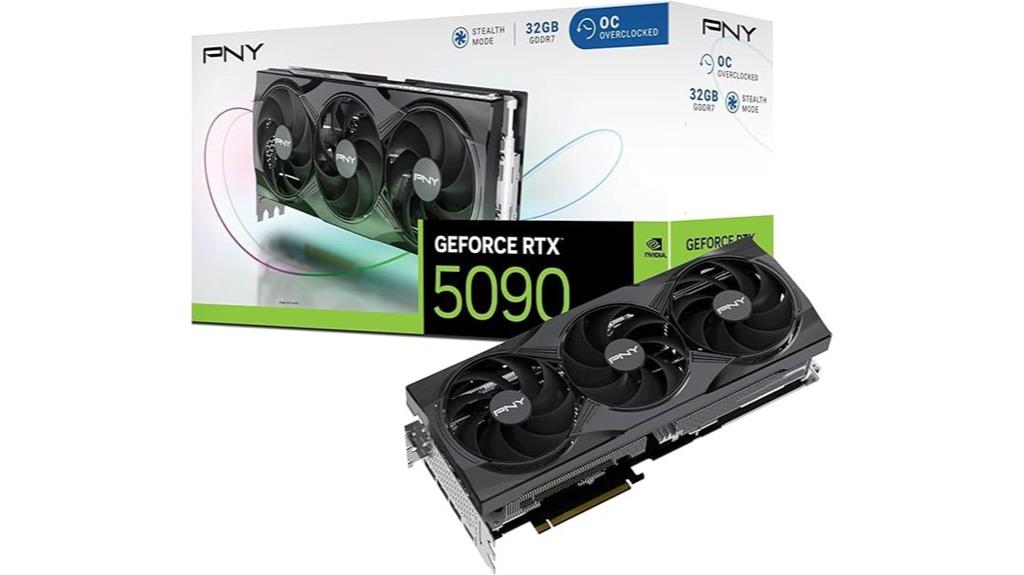
If you’re seeking a portable GPU that can handle demanding machine learning workloads with ease, the PNY NVIDIA GeForce RTX™ 5090 32GB stands out as an exceptional choice. Built on NVIDIA Blackwell architecture, it boasts 32GB of ultra-fast GDDR7 memory, supporting high-resolution tasks up to 7680×4320. Its powerful performance delivers over 200 FPS in 4K gaming and excels in AI workloads like Stable Diffusion. The cooling system keeps temperatures low, ensuring stable performance. While its large size and 600W power draw mean it’s best suited for high-end setups, its impressive speed, stability, and future-proof features make it a top contender for portable machine learning solutions.
Best For: high-end gamers, creative professionals, and AI researchers seeking maximum performance and future-proof graphics capabilities in demanding workloads.
Pros:
- Exceptional performance with over 200 FPS in 4K gaming and advanced AI workloads
- Robust cooling system maintaining low temperatures for stable operation
- Large 32GB GDDR7 memory and compatibility with PCIe® 5.0 ensure future-proofing and handling of intensive tasks
Cons:
- High price point around €3000, limiting accessibility for some users
- Large size and top-mounted power connector may require a spacious case and careful installation
- Power demands up to 600W necessitate a high-capacity power supply
External GPU Docking Station with AMD Radeon 7600M Graphics Card
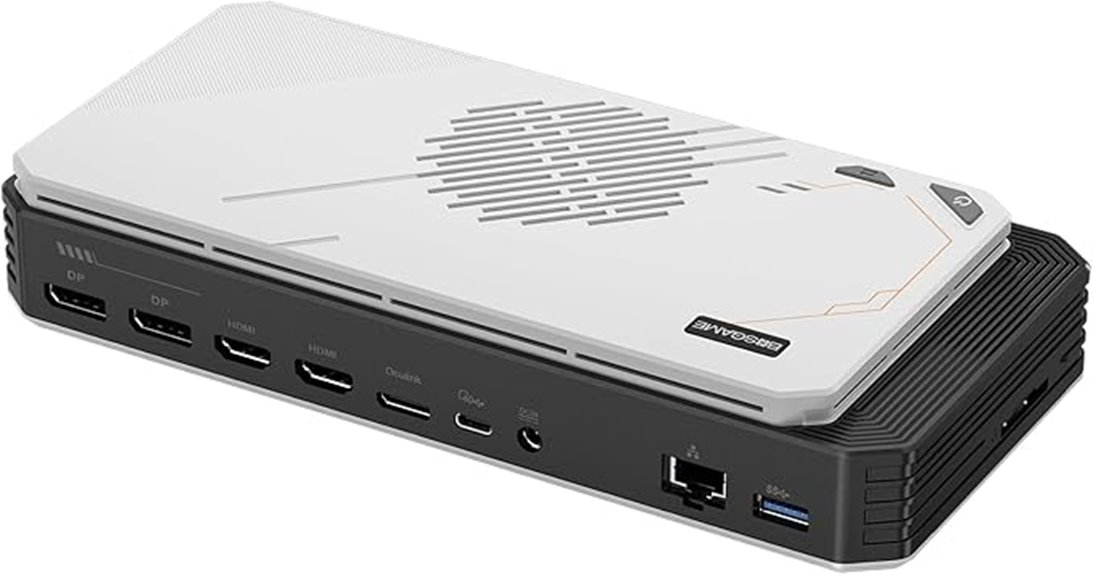
Mobile machine learning practitioners seeking a compact yet powerful GPU solution will find the external GPU docking station with AMD Radeon RX 7600M ideal. This device, part of BOSGAME’s Advance Series GVP7600M, packs an 8GB DDR5 RDNA 3.0 GPU into a small, portable package. It supports four monitors simultaneously via HDMI2.1 and DisplayPort2.0, with versatile connectivity options like Thunderbolt 4, USB4, Gigabit Ethernet, and an SSD slot. The docking station offers two operation modes—full power or eco mode—enabling balanced performance and portability. Its sleek design, easy maintenance, and solid performance make it a practical choice for enhancing graphics on the go.
Best For: mobile gamers, content creators, and machine learning practitioners seeking a portable yet powerful external GPU solution to enhance graphics performance on the go.
Pros:
- Compact, lightweight design for easy portability and travel-friendly use
- Supports four monitors simultaneously with HDMI2.1 and DisplayPort2.0 outputs
- Easy maintenance with removable fan, heatsinks, and expandable SSD slot
Cons:
- Performance slightly below high-end desktop GPUs, especially compared to Nvidia RTX 4070
- Compatibility and driver issues on Windows 11 may require troubleshooting or switching OS
- Lacks detailed setup instructions in the manual, potentially challenging for some users
ASUS TUF Gaming GeForce RTX 5090 32GB Graphics Card
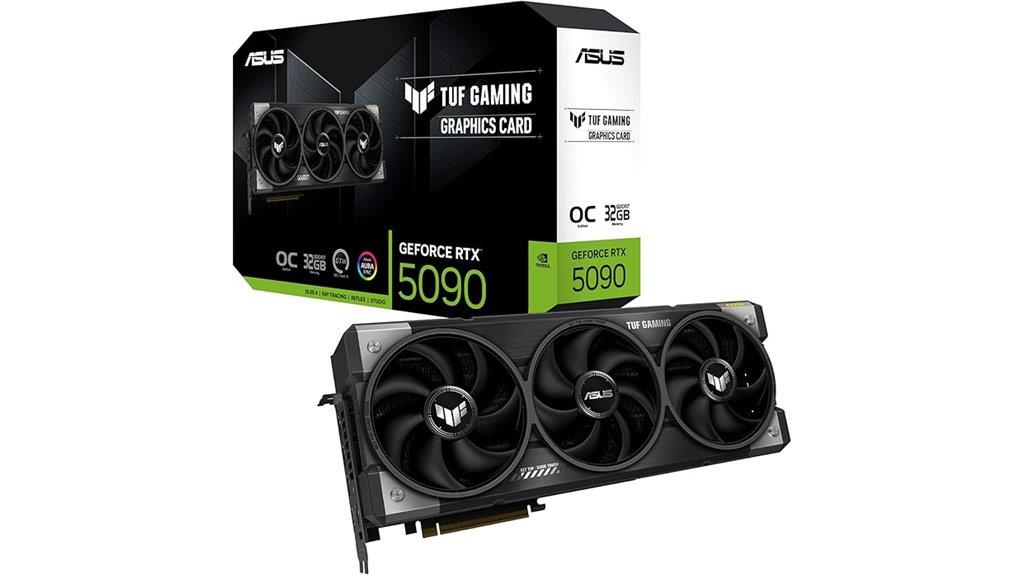
The ASUS TUF Gaming GeForce RTX 5090 32GB Graphics Card stands out as an ideal choice for machine learning enthusiasts who need top-tier performance in a portable form factor. Built with NVIDIA’s Blackwell architecture, it offers DLSS 4, advanced cooling, and 32 GB of GDDR7 VRAM. Its robust construction includes military-grade components, vapor chamber cooling, and a sleek design with customizable RGB. Despite its massive size and high power consumption—requiring an 850W PSU—it delivers exceptional performance for demanding AI tasks, 4K workloads, and content creation. While expensive and large, its durability, thermal efficiency, and cutting-edge features make it a powerhouse for portable machine learning setups.
Best For: enthusiasts and professionals seeking high-end graphics performance for machine learning, content creation, and demanding gaming in a portable yet powerful setup.
Pros:
- Exceptional performance with NVIDIA Blackwell architecture and DLSS 4 for demanding AI and gaming tasks
- Robust build quality with military-grade components and advanced cooling for durability and thermal efficiency
- Customizable RGB lighting and multiple connectivity options for enhanced aesthetics and versatility
Cons:
- Very large and heavy size requiring spacious cases and support brackets
- High power consumption demanding an 850W PSU and multiple power connectors
- Premium price point making it less accessible for casual or budget-conscious users
ASUS GeForce RTX 5080 16GB GDDR7 Graphics Card

The ASUS GeForce RTX 5080 16GB GDDR7 Graphics Card stands out as an excellent option for machine learning professionals who need high performance in a compact form. Its NVIDIA Blackwell architecture and 16GB GDDR7 memory deliver powerful processing capabilities, supporting DLSS 4 and rapid data handling. Designed with a 2.5-slot layout, it’s optimized for small builds, featuring premium metal construction and efficient cooling with vapor chamber, phase-change thermal pads, and axial-tech fans. Despite its size and weight (~6 pounds), it offers excellent thermal management, stable overclocking up to 3200 MHz, and smooth multitasking. It’s a high-end choice that balances power, durability, and compactness for on-the-go machine learning tasks.
Best For: machine learning professionals and high-performance users seeking a compact, durable GPU with top-tier processing power and advanced cooling.
Pros:
- Exceptional processing capabilities with 16GB GDDR7 memory and NVIDIA Blackwell architecture
- Efficient cooling system including vapor chamber and phase-change thermal pads for stable operation
- Compact 2.5-slot design suitable for small-form-factor builds without sacrificing performance
Cons:
- High price point (~$1650-$1800) may be a barrier for budget-conscious users
- Large size (~6 pounds) requiring ample case space and careful installation
- Fans can be loud at higher RPMs, potentially impacting noise-sensitive environments
PNY NVIDIA GeForce RTX 5080 16GB Graphics Card
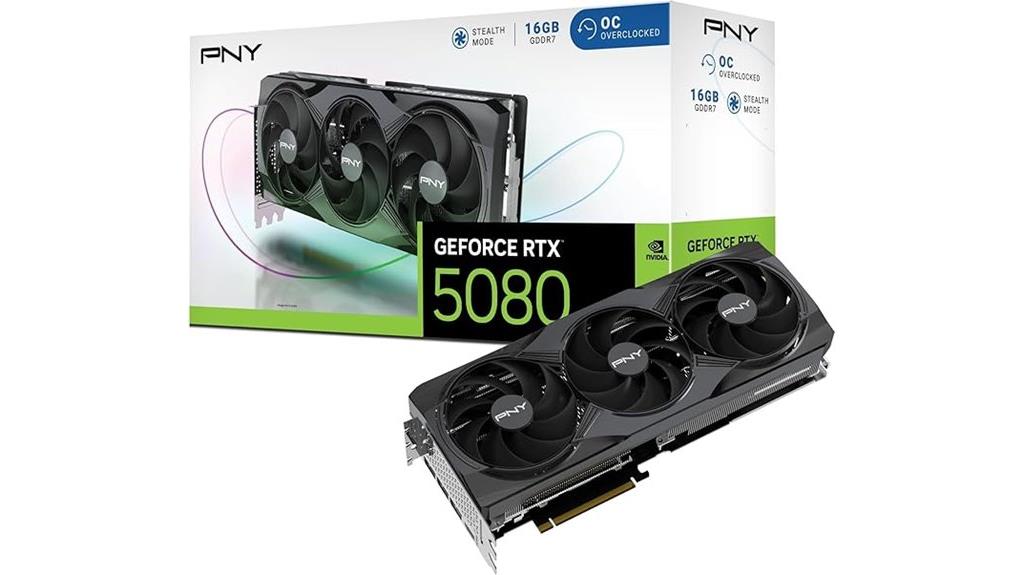
If you’re looking for a high-performance GPU that can handle demanding machine learning tasks, the PNY NVIDIA GeForce RTX 5080 16GB is an excellent choice. Built on NVIDIA’s Blackwell architecture, it features 16GB of GDDR7 memory and PCIe 5.0 support, delivering impressive speed and responsiveness. It includes advanced AI features like DLSS 4, real-time ray tracing, and NVIDIA Reflex 2, minimizing latency. Its triple-fan cooling system keeps temperatures in the mid-50s°C, ensuring stability under heavy loads. With a sleek design, customizable ARGB lighting, and quiet operation, this card combines power, aesthetics, and reliability—making it ideal for portable setups requiring top-tier performance.
Best For: high-end gamers, professional content creators, and AI/ML enthusiasts seeking top-tier graphics performance and advanced features.
Pros:
- Exceptional gaming and creative performance with NVIDIA Blackwell architecture and 16GB GDDR7 memory
- Advanced AI features including DLSS 4, real-time ray tracing, and NVIDIA Reflex 2 for reduced latency
- Efficient cooling system maintaining low temperatures and quiet operation under heavy loads
Cons:
- Limited availability due to slow production and delayed releases, affecting immediate purchase options
- Premium pricing which may be considered high compared to other high-end GPUs
- Initial driver issues reported by some users, though improvements are ongoing
PNY NVIDIA GeForce RTX™ 5070 12GB Graphics Card
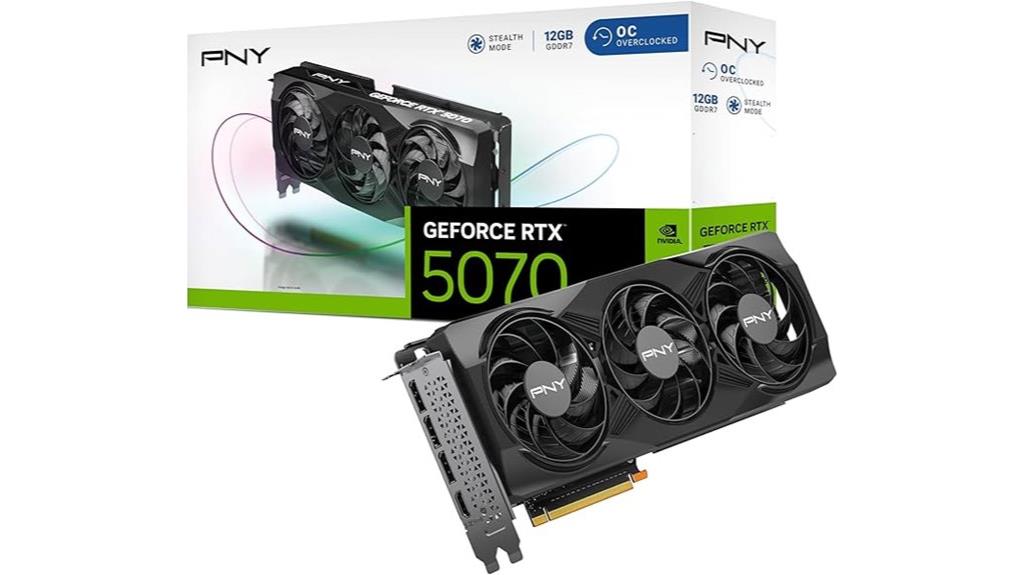
For those seeking a portable GPU capable of handling demanding machine learning tasks, the PNY NVIDIA GeForce RTX™ 5070 12GB stands out with its powerful NVIDIA Blackwell architecture and advanced AI features. It incorporates DLSS 4 for neural rendering, boosting FPS, reducing latency, and improving image quality. With Fifth-Gen Tensor Cores, Fourth-Gen Ray Tracing Cores, and high clock speeds reaching 3200 MHz, it delivers excellent performance in gaming, creative workflows, and high-resolution tasks up to 8K. Its triple-fan cooling keeps temperatures low and noise levels minimal, while its sleek, compact design guarantees compatibility with most cases. Overall, it’s a versatile, high-performance choice for on-the-go machine learning.
Best For: gamers, creative professionals, and machine learning practitioners seeking high performance, efficient cooling, and modern AI features in a compact, reliable GPU.
Pros:
- Exceptional gaming performance at 1440p and 4K with high frame rates and smooth visuals
- Quiet operation and effective triple-fan cooling system that maintains low temperatures and minimal noise
- Supports advanced AI features like DLSS 4 and is suitable for demanding creative and high-resolution tasks up to 8K
Cons:
- Priced above MSRP, making it less budget-friendly for some users
- Limited availability in certain markets, potentially affecting purchase options
- Slightly outdated software interface for RGB and overclocking management, which may require updates or third-party tools
MSI GeForce RTX 3060 12GB Gaming Graphics Card

With its compact size and powerful performance, the MSI GeForce RTX 3060 12GB Gaming Graphics Card is an excellent choice for those looking to deploy a portable GPU for machine learning tasks. It features the NVIDIA GeForce RTX 3060 GPU with a 1710 MHz core clock and 12GB of high-speed G6 memory, supporting resolutions up to 7680×4320. Its sleek design includes a backplate for durability, and it connects via HDMI 2.1 and DisplayPort 1.4a, making multi-monitor setups easy. Despite its small form factor, it handles demanding workloads and modern AAA titles effectively, offering reliable, quiet operation and thermal efficiency—ideal for on-the-go machine learning.
Best For: users seeking a compact yet powerful GPU for portable gaming, machine learning, and high-resolution creative work.
Pros:
- Compact size and sleek design suitable for portable setups and small cases
- Excellent performance for 1080p and 1440p gaming, as well as demanding workloads like machine learning
- Reliable, quiet operation with effective thermal management even under load
Cons:
- Requires a power supply upgrade (550-600W recommended) for optimal performance
- Limited to high-speed G6 memory and a single HDMI 2.1 port, which may restrict multi-monitor configurations for some users
- Slightly higher price point compared to other mid-range GPUs with similar specifications
ONEXGPU 2nd Gen eGPU Graphics Card Dock with AMD Radeon RX 7800M
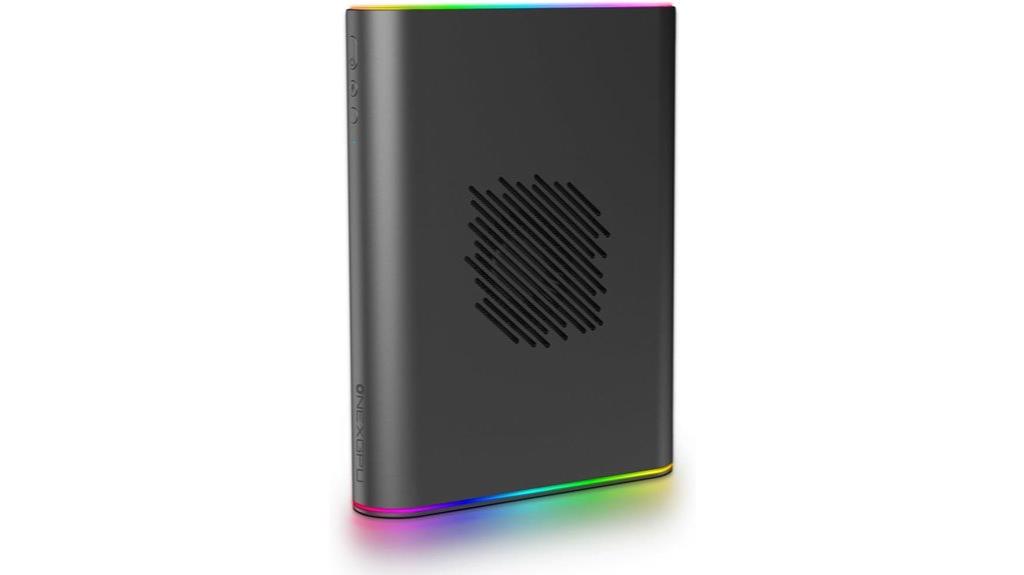
The ONEXGPU 2nd Gen eGPU Dock stands out as an ideal choice for professionals and gamers who need powerful, portable graphics performance on the go. It features the AMD Radeon RX 7800M GPU with RDNA3 architecture, 12GB GDDR6 memory, and TDP options from 130W to 180W, outperforming many laptop GPUs like the RTX 4070M. Its sleek aluminum enclosure weighs just 1.56kg, making it easy to carry. With support for up to four displays, fast connectivity via Thunderbolt 4, USB 4, and OCuLink, plus expansion options like a 4TB SSD, it combines high performance with portability for gaming, work, or machine learning tasks.
Best For: professionals and gamers who need portable, high-performance graphics and connectivity expansion on the go.
Pros:
- Powerful AMD Radeon RX 7800M GPU with RDNA3 architecture outperforms many laptop GPUs like the RTX 4070M.
- Supports up to four displays with versatile video output options (HDMI 2.1 and DisplayPort 2.0).
- Compact, lightweight design weighing only 1.56kg, with a portable aluminum enclosure and high-speed connectivity options.
Cons:
- TDP switchable to 180W may generate additional heat and noise under full load.
- Requires Thunderbolt 3/4, USB 4, or OCuLink ports, which may limit compatibility with some older devices.
- The expansion SSD slot supports up to 4TB, which might be limiting for extremely large storage needs.
GIGABYTE GeForce RTX 5060 Graphics Card (GV-N5060WF2OC-8GD)

If you’re looking for a compact yet powerful GPU to support machine learning tasks on the go, the GIGABYTE GeForce RTX 5060 offers an excellent option. It features NVIDIA’s Blackwell architecture with DLSS 4, RT Cores, and Tensor Cores, making it ideal for AI workloads. With 8GB GDDR7 memory and PCIe 5.0 compatibility, it delivers high performance and visuals while remaining lightweight at just 1.65 pounds. Its triple-fan WINDFORCE cooling keeps temperatures low and noise minimal. The card performs well at 1080p and 1440p, ensuring smooth AI training and inference, all in a compact, stylish design perfect for portable setups.
Best For: gamers and AI enthusiasts seeking a compact, high-performance graphics card for 1080p/1440p gaming and machine learning tasks.
Pros:
- Compact, lightweight design with a stylish appearance for easy installation and portability
- Excellent cooling performance with quiet operation due to WINDFORCE triple-fan system
- Strong performance at 1080p and 1440p with advanced features like DLSS 4 and ray tracing cores
Cons:
- Slightly higher initial setup complexity due to firmware updates and compatibility considerations
- Limited performance gains at higher resolutions like 4K compared to more powerful GPUs
- Potential driver stability issues on Linux or Windows 11, requiring updates for optimal performance
Maxsun GeForce RTX 3050 6GB Graphics Card
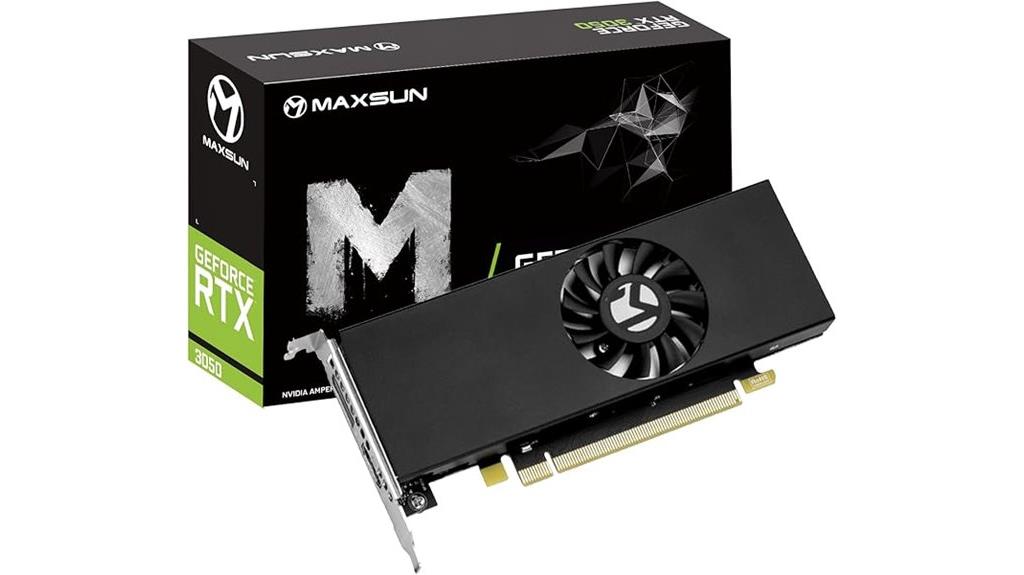
For users seeking a compact GPU solution that balances performance and size, the Maxsun GeForce RTX 3050 6GB Graphics Card fits perfectly into small form factor builds, especially when working on machine learning projects with limited space. Its NV Ampere architecture supports DLSS and AI Tensor Cores, boosting AI tasks without sacrificing image quality. With 6GB GDDR6 memory and a slim low-profile design, it’s ideal for Mini ITX setups and SFF cases. While not top-tier, it outperforms integrated graphics, making it suitable for casual ML workloads, multimedia, and gaming in constrained environments. Just note the cooling isn’t ideal, so manage thermal performance accordingly.
Best For: users seeking a compact, affordable GPU for small form factor builds, casual gaming, multimedia, and light machine learning tasks in limited spaces.
Pros:
- Compact, low-profile design fits SFF and Mini ITX cases easily
- Supports advanced features like DLSS and AI Tensor Cores for improved performance and quality
- Outperforms integrated graphics, suitable for casual gaming and multimedia
Cons:
- Inadequate cooling leads to high temperatures and noise under load
- Lacks a blower-style cooler, increasing heat buildup and potential longevity issues
- Overpriced due to high demand, with some reports of overheating and loud fans
PNY NVIDIA GeForce RTX 5060 8GB Graphics Card
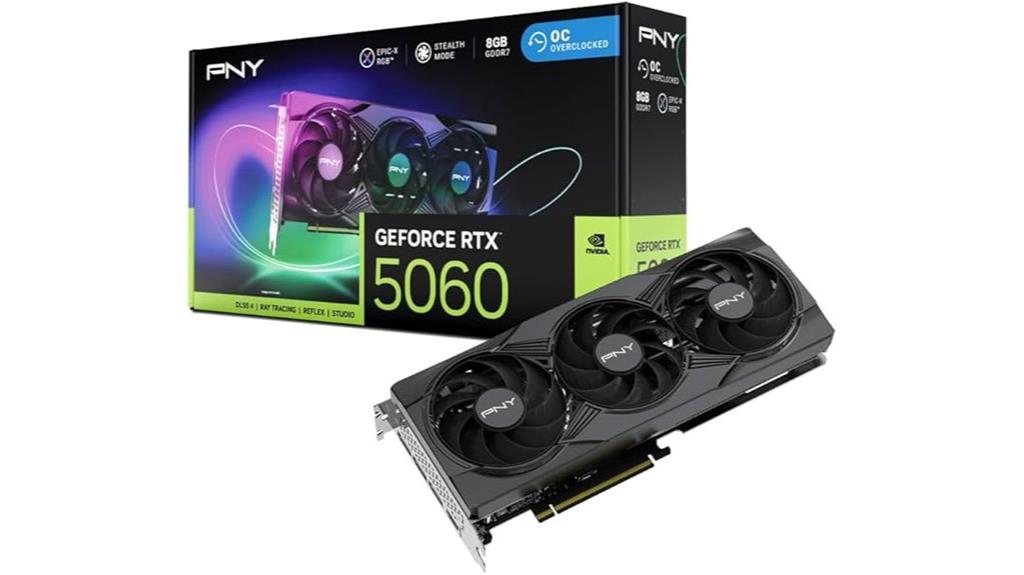
Powered by NVIDIA Blackwell architecture, the PNY NVIDIA GeForce RTX 5060 8GB Graphics Card delivers impressive AI acceleration and high-performance gaming, making it ideal for those who need a portable GPU to handle machine learning workloads on the go. It features DLSS 4, AI-powered rendering, and supports PCIe 5.0, HDMI 2.1, and DisplayPort 2.1, ensuring fast data transfer and high-resolution output. With triple fans for cooling and overclocked performance, it handles high-res tasks smoothly. Its 8GB VRAM and advanced cores optimize AI tasks and creative workflows, providing a versatile, compact option for machine learning, gaming, and content creation in a portable form factor.
Best For: gamers, creative professionals, and AI developers seeking high-performance, portable GPU with advanced rendering and AI acceleration capabilities.
Pros:
- High-performance gaming with DLSS 4 and overclocked speeds for smooth gameplay at high resolutions
- Supports PCIe 5.0, HDMI 2.1, and DisplayPort 2.1 for fast data transfer and high-quality output
- Compact design with triple fans for effective cooling, suitable for portable setups and creative workflows
Cons:
- Potential issues with power supply compatibility or missing cables, requiring careful installation
- Some users report concerns about counterfeit or scam vendors, especially from unknown sources
- Limited user reviews (average 4.0 stars), indicating that long-term reliability and performance feedback are still emerging
External GPU Docking Station GVP7600 Core with AMD Radeon 7600M Graphics Card

The External GPU Docking Station GVP7600 Core with AMD Radeon 7600M Graphics Card is an excellent choice for anyone looking to expand their mini PC’s graphics capabilities, especially for machine learning tasks. It supports high-resolution outputs up to 8K and offers robust connectivity via Thunderbolt 3, USB 4.0, or Oculink. With the AMD Radeon RX 7600M onboard, it delivers efficient performance and smooth gaming, which benefits ML workloads. Easy to set up with just a cable connection, it features multiple I/O options, including DisplayPort, HDMI, and Ethernet. Overall, it transforms compact setups into powerful workstations with minimal fuss.
Best For: users seeking to upgrade their mini PC’s graphics and connectivity capabilities for gaming, high-resolution displays, and machine learning workloads with a compact and efficient solution.
Pros:
- Supports high-resolution outputs up to 8K and multiple display options including DisplayPort and HDMI for versatile visual setup
- Compact design with easy plug-and-play setup via Thunderbolt 3, USB 4.0, or Oculink, transforming mini PCs into full workstations
- Equipped with AMD Radeon RX 7600M graphics card offering efficient performance for gaming and ML tasks, plus robust I/O options including Ethernet and SD card slot
Cons:
- Not hot-swappable PCIe 4.0 x4 slot limits ease of hardware upgrades or modifications
- Does not support DLSS technology, which may impact performance in certain compatible games or applications
- Requires driver installation and proper recognition process, which may be challenging for less tech-savvy users
NVIDIA Tesla A100 Ampere 40 GB Graphics Processor
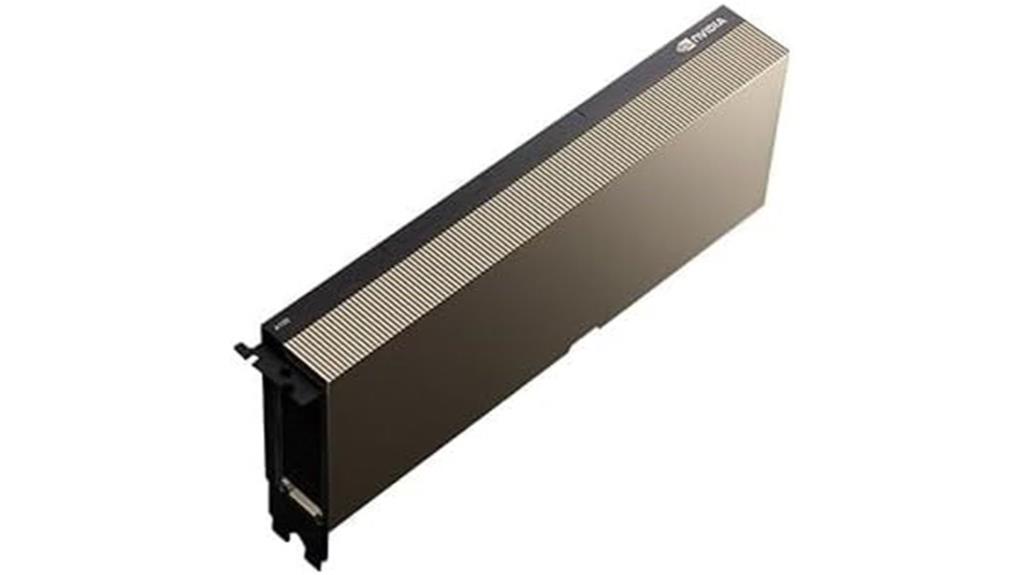
If you’re seeking a high-performance GPU capable of handling demanding machine learning tasks in a data center or professional environment, the NVIDIA Tesla A100 Ampere 40 GB stands out. It features PCIe 4.0 x16 interface, dual-slot design, and 40 GB of memory, making it ideal for AI, data analytics, and HPC workloads. Its third-generation Tensor Cores accelerate various precisions, boosting speed and efficiency. With NVIDIA Multi-Instance GPU technology, it can partition into seven instances, scaling for both large and small tasks. Though it has limited consumer support and no manufacturer warranty beyond six months, its raw power and scalability make it a top choice for serious machine learning applications.
Best For: professionals and organizations requiring high-performance GPU acceleration for AI, data analytics, and HPC workloads in data center environments.
Pros:
- Exceptional scalability with support for thousands of GPUs and Multi-Instance GPU technology
- Advanced third-generation Tensor Cores for diverse precision acceleration
- Robust platform designed specifically for demanding enterprise AI and HPC applications
Cons:
- Limited consumer support and no manufacturer warranty beyond six months
- Relatively high weight and passive cooling may require specialized setup
- Mixed user reviews indicating performance may vary depending on specific applications
Factors to Consider When Choosing Portable GPUs for Machine Learning

When selecting a portable GPU for machine learning, I focus on key factors like performance, VRAM, and compatibility with my setup. Size, cooling, and power requirements also matter to guarantee I get a balance between efficiency and convenience. Considering these points helps me choose a GPU that meets my needs without sacrificing portability or performance.
Performance and VRAM
Ever wondered why VRAM capacity matters so much when choosing a portable GPU for machine learning? VRAM is essential because it determines how well the GPU can handle large models and datasets. Modern portable GPUs with at least 8GB of VRAM can support most ML workloads, but bigger models really benefit from 16GB or more to avoid memory bottlenecks. The size of VRAM impacts the ability to process high-resolution data and complex neural networks without performance drops or frequent data swapping. GPU performance, including CUDA and tensor cores, works together with VRAM to speed up training and inference. Selecting a GPU with sufficient VRAM guarantees smoother workflows, reduces the need for multiple GPUs, and keeps your machine learning projects running efficiently on the go.
Compatibility and Connectors
Choosing a portable GPU for machine learning requires careful attention to compatibility and connectors, as these guarantee smooth integration with your system. Make sure the GPU’s connection interfaces, like Thunderbolt 3/4, USB 4, or PCIe 4.0/5.0, match your laptop or workstation ports. Check if the external enclosure or docking station supports the necessary power delivery standards to provide sufficient wattage and charging. High data transfer rates are vital, so look for Thunderbolt 4 or USB 4 support to handle large datasets efficiently. Additionally, verify the availability of multiple video outputs such as HDMI 2.1 or DisplayPort 2.0 for multi-monitor setups. Finally, consider the physical placement and cable compatibility to guarantee stable, strain-free connections during intensive workloads.
Portability and Size
Selecting a portable GPU for machine learning hinges on its size and weight, as these factors directly impact mobility. A lightweight GPU, ideally under 2.5 kg (5.5 lbs), makes transportation effortless. Compact dimensions, around 15 inches or less, guarantee compatibility with smaller cases and carrying bags. Small form factors with 2-3 slot widths fit easily into various laptop docks or mini PC setups. Additionally, the power supply should be manageable, typically requiring no more than 600W, so you can use portable power sources without hassle. Overall, choosing a GPU with the right balance of size, weight, and ease of integration is vital for seamless mobile workflows. This balance ensures you can work efficiently whether on the road or in tight spaces.
Cooling and Thermal
Effective cooling is critical when using portable GPUs for machine learning, especially during intensive training sessions. Proper thermal management prevents overheating, which can cause thermal throttling and reduce performance. Technologies like vapor chambers and axial-tech fans help maintain low GPU temperatures, guaranteeing stable operation. Good heat dissipation allows portable GPUs to sustain higher clock speeds and consistent training speeds, essential for large models. In compact or poorly ventilated setups, overheating risks increase, making external cooling solutions or improved airflow crucial. Monitoring temperature metrics—such as keeping loads below 70°C—is key to optimizing performance and avoiding hardware failures. Ultimately, choosing a GPU with efficient cooling capabilities assures reliable, sustained performance during demanding machine learning tasks on the go.
Power Requirements
Power requirements are a vital factor when setting up portable GPUs for machine learning, as these units often demand substantial energy to perform at high levels. Depending on the model, power consumption can range from 150W to 600W, making it essential to have a compatible power supply. Many external GPU enclosures support USB-C Power Delivery (PD), allowing simultaneous charging of laptops and powering the GPU. Matching the GPU’s peak power needs with the right PSU is indispensable to guarantee stable operation and prevent throttling or shutdowns during intensive tasks. High-end GPUs may require dedicated power connectors like 8-pin or 16-pin (12VHPWR). Proper power management also involves considering surge capacity, thermal dissipation, and making certain the enclosure can handle peak loads safely.
Price and Value
When choosing a portable GPU for machine learning, price and value are critical considerations that can determine how well the investment pays off. High-end models like the NVIDIA RTX 5090 can cost around $3,000, while more affordable options like the RTX 5070 start at $600-$700. It’s crucial to evaluate the GPU’s VRAM, as larger memory (e.g., 96GB DDR7 in the NVIDIA RTX PRO 6000) can enhance performance with big datasets, justifying a higher price. The price-to-performance ratio matters; some GPUs are costly but offer minimal gains over cheaper options. Don’t forget additional costs like cooling, power supplies, and enclosures, which impact overall value. Resale potential and warranty support also influence long-term worth, especially for premium models.
Frequently Asked Questions
How Does Portability Affect GPU Cooling and Thermal Management?
Portability definitely impacts GPU cooling and thermal management, as smaller, lightweight designs have less space for cooling solutions. I find that portable GPUs often use more aggressive fans or passive cooling methods, which can lead to higher temperatures if not properly managed. To keep things running smoothly, I make sure to use external cooling accessories or ensure good airflow during use, preventing overheating and maintaining ideal performance.
Can Portable GPUS Handle Real-Time Data Processing for Large Datasets?
Absolutely, portable GPUs can handle real-time data processing for large datasets. I’ve seen models like the RTX 4080 Mobile blitz through complex computations on the go, thanks to advanced cooling and power management. While some worry about thermal limits, these GPUs are built to optimize performance without overheating. So, with the right setup, you can confidently process big data anytime, anywhere, without missing a beat.
What Are the Power Consumption Differences Among These Portable GPUS?
Power consumption varies quite a bit among portable GPUs. High-end models like the RTX 4080 tend to use more power, often around 150-200W, while more efficient options like the RTX 4060 stay below 150W. I always check the specs before buying, because lower power consumption means longer battery life and less heat, which is vital for portable use. If you’re on the go, balancing performance and efficiency is key.
How Compatible Are These GPUS With Various Operating Systems and ML Frameworks?
These portable GPUs are generally quite compatible with popular operating systems like Windows, Linux, and macOS, but I recommend double-checking specific model details. Most support major ML frameworks like TensorFlow and PyTorch, often through CUDA or ROCm. I always guarantee driver support and software updates are current to avoid compatibility issues. Overall, they integrate smoothly, making it easier to run machine learning tasks on the go.
What Is the Expected Lifespan of Portable GPUS Under Continuous Machine Learning Workloads?
I expect portable GPUs for machine learning to last around 3 to 5 years under continuous workloads. Their lifespan depends on factors like usage intensity, cooling, and build quality. Regular maintenance, proper ventilation, and avoiding overheating can extend their life. I recommend monitoring performance and temperatures to prevent early failures. With good care, these GPUs can serve you well for several impactful years in your ML projects.
Conclusion
Choosing the right portable GPU feels like balancing power with portability. On one hand, high-performance cards like the NVIDIA RTX 5090 deliver raw speed, but they can be bulky and costly. On the other, compact options may sacrifice some power but offer unmatched mobility. Ultimately, it’s about finding that sweet spot where your machine learning needs meet your on-the-go lifestyle—because sometimes, the most portable tool isn’t always the most powerful, but it might just be the most essential.


